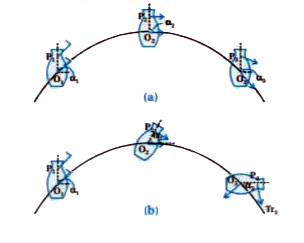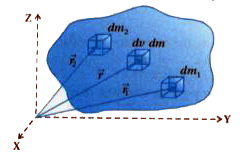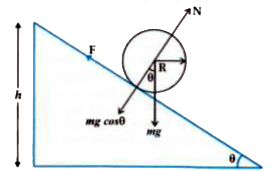Complete Solutions to SECTION-A QUESTIONS - ANSWERS of chapter SYSTEMS OF PARTICLES AND ROTATIONAL MOTION of Class 11 book with complete answers and questions
| Class 11 | PHYSICS |
| Chapter | SYSTEMS OF PARTICLES AND ROTATIONAL MOTION |
| KUMAR PRAKASHAN | SECTION-A QUESTIONS - ANSWERS |
| Number Of Questions | 64 |
| Academic Year | 2023-24 |
What is a rigid body ? Explain the differences between rigid body and solid body.
01:57View SolutionExplain translational motion by given illustration.
 02:11View Solution
02:11View SolutionWhat is rotational motion? Explain it with example.
 03:33View Solution
03:33View SolutionCharacteristic of rotational motion.
02:06View SolutionExplain with illustration the pure translation and combination of translation and rotation motion of rigid body.
 04:27View Solution
04:27View SolutionWhat is system of particle?
01:14View SolutionDefine centre of mass.
01:04View SolutionObtain an expression for the position vector of centre of mass of a system of n particles in one dimension.
01:50View SolutionObtain an expression for the position vector of centre of mass of a system n particles in two dimension.
02:25View SolutionObtain the general expression of centre of mass for distributed n particles of system in three dimension.
02:37View SolutionFor determining centre of mass of a body why a body is considered as composited of multiple of small mass elements?
02:07View SolutionExplain the theoretical method for estimation of the centre of mass of a solid body.
 03:31View Solution
03:31View SolutionObtain the position of centre of mass of a thin rod of uniform density.
03:21View SolutionWrite the expression of centre of mass of a system of .n. particles and derive the formula of force acting on its centre of mass.
03:43View SolutionDiscuss the forces acting on the n particles in a system.
05:32View SolutionSome of notable matters in derivation of `MvecA=vec(F)_(ext)`.
02:58View SolutionHow can general body be obtained?
02:27View SolutionDiscuss the explosion of projectile.
 02:59View Solution
02:59View SolutionObtain an expression for the velocity of centre of mass for n particles of system.
04:07View SolutionShow that the total momentum of system of particles is equal to the product of total mass of system and velocity of centre of mass.
06:50View SolutionObtain Newton.s second law for system of particle and write it.
02:36View SolutionState the explain the law of conservation of momentum of the system of particle.
02:40View SolutionExplain the conservation of linear momentum for the radioactive decay of radium nucleus.
03:01View SolutionDiscuss the occurrence of binary (double) stars in a astronomy.
02:30View SolutionExplain cross product of two vectors.
03:12View SolutionState and explain right hand screw rule.
01:53View SolutionState and explain the charateristics of vector product of two vectors.
02:46View SolutionExplain with defination of angular position, angular displacement and angular speed for the motion of rigid body.
03:55View SolutionExplain that angular velocity is a vector and its direction is given by right hand screw rule.
03:26View SolutionRelation between linear and angular velocity for object in rotational motion is `vecv=vecrxxvecomega`
03:49View SolutionDefine angular acceleration.
01:49View SolutionWhat is torque? Explain the torque acting on a particle.
01:55View SolutionExplain linear and angular momentum.
05:42View SolutionExplain Cartesian components of angular momentum of a particle.
01:46View SolutionObtain the relation between angular momentum of a particle and torque acting on it.
05:02View SolutionObtain the relation between angular momentum of a particle and torque acting on it.
05:02View SolutionWrite the law of conservation of angular momentum.
03:57View SolutionWrite condition of translational equilibrium of particle.
02:25View SolutionCan a body will remain in partial equilibrium? Explain with illustration.
02:29View SolutionWhat is couple? Give its illustration.
02:36View SolutionExplain the construction and working of an ideal lever and also explain the principle of moment of force.
04:30View SolutionWrite short note on centre of Gravity.
01:30View SolutionWrite the difference between centre of gravity and centre of mass of a body?
02:48View SolutionObtain the expression of moment of inertia and define it. What are the factors on which moment of inertia depends? Write its unit and dimensional formula.
04:18View SolutionFind the moment of inertia of ring about an axis passing through the centre and perpendicular to its plane.
02:42View SolutionFind the moment of inertia of thin and massless rod about an axis passing through its centre of mass of rod and pair of mass is suspended on both end of this rod.
02:48View SolutionWrite the short note on radius of gyration.
04:39View SolutionWrite the short note on radius of gyration.
04:39View SolutionWrite the practical uses of moment of inertia.
01:46View SolutionState and prove theorem of perpendicular axes.
03:56View SolutionState and prove theorem of parallel axis.
03:10View SolutionExplain angular velocity and angular acceleration about fixed axis and derive the equation of rotational motion and write the analogy between the equations of linear motion and rotational motion.
 03:51View Solution
03:51View SolutionWhich matters should take in mind for calculation of torque and which are not?
04:44View SolutionExplain work done by torque.
04:20View SolutionExplain work done by torque.
04:20View SolutionObtain the relation between angular momentum of a particle and torque acting on it.
05:02View SolutionDerive the equation of angular momentum in the case of rotational motion about a fixed axis.
03:26View SolutionObtain `tau=Ialpha` from angular momentum of rigid body.
02:22View SolutionWrite the law of conservation of angular momentum.
03:57View SolutionObtain the necessary condition `v_(cm)=Romega` for rolling body without stepping.
03:45View SolutionDerive an expressions for the kinetic energy and velocity on an inclined plane of inclination `theta` for the body rolling without sliding.
04:48View SolutionLittle more for rolling body :
 06:53View Solution
06:53View SolutionBy accepting a equation of friction force `F=mgsintheta{(k^(2))/(k^(2)+R^(2))}` derive an expression for the static friction of rolling body from the slope.
03:04View SolutionBy accepting a equation for the static friction of rolling body from the slope, obtain the condition for rolling on the slope :
03:34View Solution
SECTION-A QUESTIONS - ANSWERS questions and complete solutions for chapter SYSTEMS OF PARTICLES AND ROTATIONAL MOTION of KUMAR PRAKASHAN KENDRA PHYSICS (GUJRATI ENGLISH) of Class 11
All Exercises from KUMAR PRAKASHAN Class 11 PHYSICS SYSTEMS OF PARTICLES AND ROTATIONAL MOTION
- SECTION-A (TRY YOURSELF (VSQs))
- SECTION-A HOTS
- SECTION-A QUESTIONS - ANSWERS
- SECTION-B ADDITIONAL EXERCISE
- SECTION-B NUMERICAL FROM .DARPAN. BASED ON TEXTBOOK
- SECTION-B NUMERICALS
- SECTION-B NUMERICALS FROM TEXTUAL EXERCISE
- SECTION-C OBJECTIVE QUESTIONS (VSQs)
- SECTION-D NCERT EXEMPLAR SOLUTIONS
- SECTION-D NCERT EXEMPLAR SOLUTIONS (LONG ANSWER TYPE QUESTIONS)
- SECTION-D NCERT EXEMPLAR SOLUTIONS (SHORT ANSWER TYPE QUESTIONS)
- SECTION-D NCERT EXEMPLAR SOLUTIONS (VERY SHORT ANSWER TYPE QUESTIONS)
- SECTION-E MULTIPLE CHOICE QUESTIONS
- SECTION-F (SECTION-A) QUESTIONS PAPER
- SECTION-F (SECTION-B) QUESTIONS PAPER
- SECTION-F (SECTION-C) QUESTIONS PAPER
- SECTION-F (SECTION-D) QUESTIONS PAPER
- SECTION-F QUESTIONS FROM MODULE
